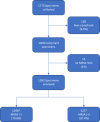Automated detection of methicillin-resistant Staphylococcus aureus with the MRSA CHROM imaging application on BD Kiestra Total Lab Automation System
- PMID: 38557148
- PMCID: PMC11077980
- DOI: 10.1128/jcm.01445-23
Automated detection of methicillin-resistant Staphylococcus aureus with the MRSA CHROM imaging application on BD Kiestra Total Lab Automation System
Abstract
The virulence of methicillin-resistant Staphylococcus aureus (MRSA) and its potentially fatal outcome necessitate rapid and accurate detection of patients colonized with MRSA in healthcare settings. Using the BD Kiestra Total Lab Automation (TLA) System in conjunction with the MRSA Application (MRSA App), an imaging application that uses artificial intelligence to interpret colorimetric information (mauve-colored colonies) indicative of MRSA pathogen presence on CHROMagar chromogenic media, anterior nares specimens from three sites were evaluated for the presence of mauve-colored colonies. Results obtained with the MRSA App were compared to manual reading of agar plate images by proficient laboratory technologists. Of 1,593 specimens evaluated, 1,545 (96.98%) were concordant between MRSA App and laboratory technologist reading for the detection of MRSA growth [sensitivity 98.15% (95% CI, 96.03, 99.32) and specificity 96.69% (95% CI, 95.55, 97.60)]. This multi-site study is the first evaluation of the MRSA App in conjunction with the BD Kiestra TLA System. Using the MRSA App, our results showed 98.15% sensitivity and 96.69% specificity for the detection of MRSA from anterior nares specimens. The MRSA App, used in conjunction with laboratory automation, provides an opportunity to improve laboratory efficiency by reducing laboratory technologists' labor associated with the review and interpretation of cultures.
Keywords: BD Kiestra; lab automation; methicillin-resistant Staphylococcus aureus (MRSA).
Conflict of interest statement
S.M., J.L., D.M., C.O., J.-M.V., and K.B. are employees of the study sponsor, Becton, Dickinson and Company, and own BD shares; these authors have no other potential conflict of interest to disclose. D.R. has received research support for this investigation. He has also performed sponsored research in collaboration with Abbott, Altona, BD, bioMerieux, Cepheid, Luminex, Hardy Diagnostics, HelixBind, Hologic, Qiagen, Q-Linea, Roche, Specific Diagnostics, Cleveland Diagnostics, Thermo Fisher, & Vela Diagnostics; served as an advisor for Roche, Thermo Fisher, Luminex/DiaSorin, Seegene; received travel funds from Cepheid; and owns equity in Next Gen Diagnostics. M.D. has received research support for this investigation. P.P. and C.E.G. do not have conflicts of interest to disclose. E.M. has received research support for this investigation and is a sponsored speaker for BD.
Figures


Similar articles
-
Comparison of an Automated Plate Assessment System (APAS Independence) and Artificial Intelligence (AI) to Manual Plate Reading of Methicillin-Resistant and Methicillin-Susceptible Staphylococcus aureus CHROMagar Surveillance Cultures.J Clin Microbiol. 2021 Oct 19;59(11):e0097121. doi: 10.1128/JCM.00971-21. Epub 2021 Aug 11. J Clin Microbiol. 2021. PMID: 34379525 Free PMC article.
-
Automated Scoring of Chromogenic Media for Detection of Methicillin-Resistant Staphylococcus aureus by Use of WASPLab Image Analysis Software.J Clin Microbiol. 2016 Mar;54(3):620-4. doi: 10.1128/JCM.02778-15. Epub 2015 Dec 30. J Clin Microbiol. 2016. PMID: 26719443 Free PMC article.
-
Evaluation of a new selective medium, BD BBL CHROMagar MRSA II, for detection of methicillin-resistant Staphylococcus aureus in different specimens.J Clin Microbiol. 2010 Jun;48(6):2223-7. doi: 10.1128/JCM.02374-09. Epub 2010 Apr 14. J Clin Microbiol. 2010. PMID: 20392927 Free PMC article.
-
Diagnostic accuracy of culture-based and PCR-based detection tests for methicillin-resistant Staphylococcus aureus: a meta-analysis.Clin Microbiol Infect. 2011 Feb;17(2):146-54. doi: 10.1111/j.1469-0691.2010.03202.x. Clin Microbiol Infect. 2011. PMID: 20219085
-
Robotization in microbiology.Ann Biol Clin (Paris). 2024 Nov 30;82(5):489-499. doi: 10.1684/abc.2024.1922. Ann Biol Clin (Paris). 2024. PMID: 39612297 Review.
Cited by
-
Advanced One-Pot RPA-CRISPR/Cas12a Reaction with Glycerol and Betaine for High-Sensitivity Diagnosis of mecA-Carrying Strains in Clinical Samples.ACS Omega. 2025 Jan 31;10(5):4599-4606. doi: 10.1021/acsomega.4c09078. eCollection 2025 Feb 11. ACS Omega. 2025. PMID: 39959114 Free PMC article.
-
Culture harder: use more specimens to increase methicillin-resistant Staphylococcus aureus culture yield relative to PCR.Access Microbiol. 2025 Jun 3;7(6):000918.v4. doi: 10.1099/acmi.0.000918.v4. eCollection 2025. Access Microbiol. 2025. PMID: 40475911 Free PMC article.
-
Development and validation of a hierarchical machine learning method using MALDI-TOF mass spectrometry for rapid SCCmec typing and PVL detection in MRSA: a multi-centre study.Emerg Microbes Infect. 2025 Dec;14(1):2525264. doi: 10.1080/22221751.2025.2525264. Epub 2025 Jul 17. Emerg Microbes Infect. 2025. PMID: 40576568 Free PMC article.
-
Revolutionizing Laboratory Practices: Pioneering Trends in Total Laboratory Automation.Ann Lab Med. 2025 Sep 1;45(5):472-483. doi: 10.3343/alm.2024.0581. Epub 2025 Apr 7. Ann Lab Med. 2025. PMID: 40190248 Free PMC article. Review.
References
-
- Burckhardt I, Horner S, Burckhardt F, Zimmermann S. 2018. Detection of MRSA in nasal swabs-marked reduction of time to report for negative reports by substituting classical manual workflow with total lab automation. Eur J Clin Microbiol Infect Dis 37:1745–1751. doi:10.1007/s10096-018-3308-5 - DOI - PMC - PubMed
-
- Centers for Disease Control and Prevention NCfEaZIDN, Division of Healthcare Quality Promotion (DHQP) . 2019. Methicillin-resistant Staphylococcus aureus (MRSA). Available from: https://www.cdc.gov/mrsa/community/index.html. Retrieved 27 Apr 2022.
Publication types
MeSH terms
LinkOut - more resources
Full Text Sources
Medical
Molecular Biology Databases
Miscellaneous

